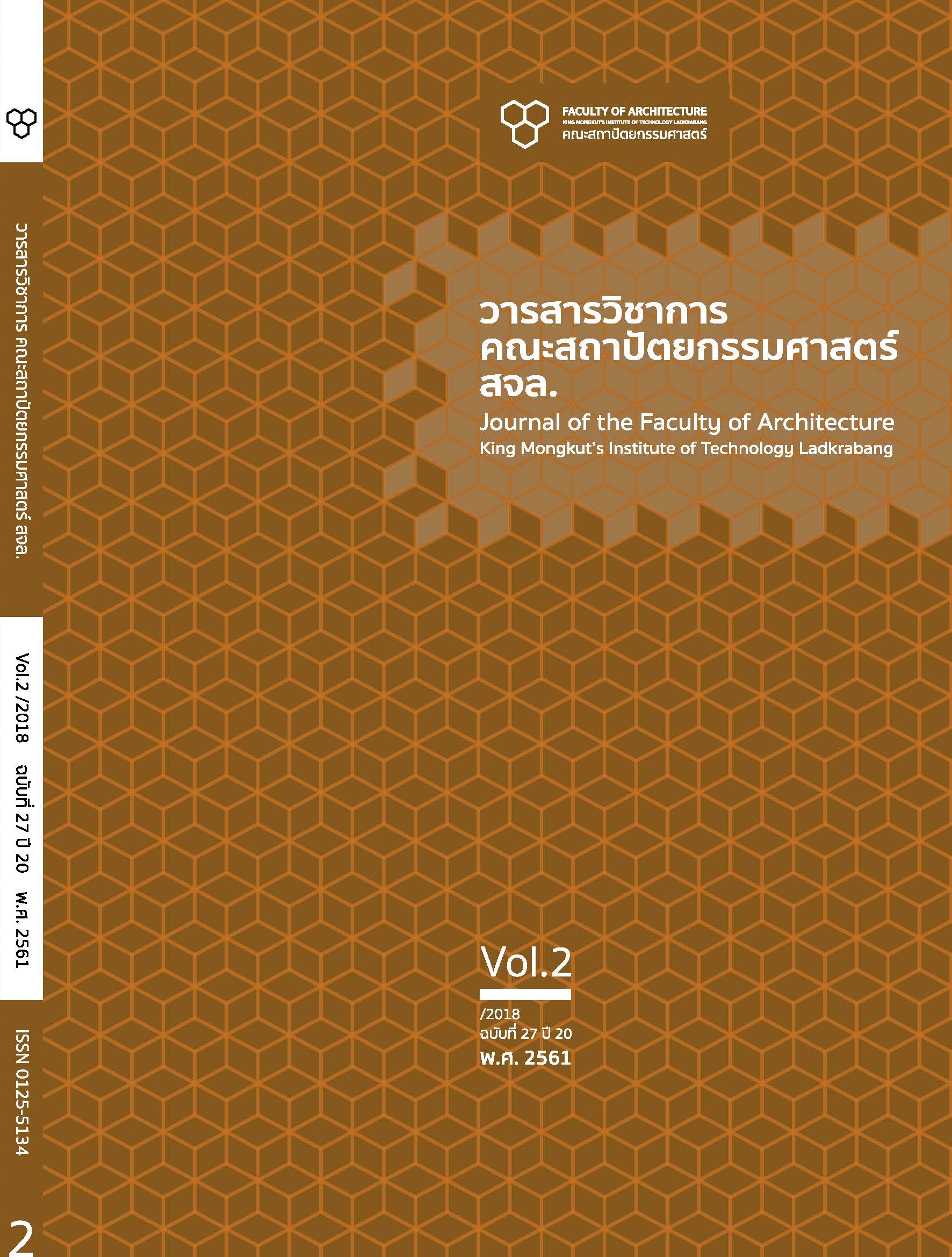การศึกษาสภาพปัญหาและแนวทางการปรับปรุงวิธีการเรียนการสอน กลุ่มวิชาเทคโนโลยีโครงสร้างและงานระบบอาคาร A Study of the Problems and the Improvement Direction of Teaching and Learning Methods in the Field of Building Construction Technology and Building System
Main Article Content
Abstract
บทคัดย่อ
งานวิจัยนี้มีวัตถุประสงค์เพื่อศึกษาสภาพปัญหาการเรียนการสอนในกลุ่มวิชาเทคโนโลยีอาคารเพื่อออกแบบ แนวทางการปรับปรุงวิธีการเรียนการสอนเพื่อให้เกิดผลสัมฤทธิ์ทางการเรียนรู้ที่เพิ่มขึ้น ผู้วิจัยมีความต้องการจะศึกษาสภาพการขาดองค์ความรู้และทักษะของนักศึกษาในการเรียนกลุ่มวิชาเทคโนโลยีการก่อสร้างอาคาร และค้นหาแนวทางการเรียนการสอนใหม่ที่มีประสิทธิภาพที่มุ่งเน้นการสร้างความเข้าใจและสร้างองค์ความรู้ให้นักศึกษา ซึ่งจะนำไปสู่การพัฒนาความรู้ความเข้าใจและสร้างความคิดสร้างสรรค์ในงานออกแบบสถาปัตยกรรมหลักและผลิตผลงานออกแบบที่มีคุณภาพได้ในอนาคต ผู้วิจัยได้กำหนดกลุ่มเป้าหมายผู้ให้ข้ อมูลจากกลุ่มนักศึกษาภาควิชาสถาปัตยกรรมที่กาลังศึกษาวิชา เทคโนโลยีการก่อสร้างอาคารระดับแรกจนถึงระดับสูงสุดและคณาจารย์ผู้สอนกลุ่มวิชาเทคโนโลยีการก่อสร้างอาคาร จากคณะสถาปัตยกรรมศาสตร์ของ 3 สถาบัน จำนวนทั้งหมด 30 คน โดยใช้การวิจัยเชิงคุณภาพผ่านการสัมภาษณ์และการสังเกตการณ์ในห้องเรียน และใช้การวิเคราะห์โดยการจำแนกชนิดข้อมูลและแบบสรุปอุปนัยจาก 1) เนื้อหาหลักสูตรในหมวดวิชาเทคโนโลยีการก่อสร้างอาคารและวิชางานระบบอาคาร 2) วิธีการสอน 3) วิธีการประเมินผลสัมฤทธิ์ทางการเรียนรู้ 4) สถานที่เรียนและอุปกรณ์การสอน ผลวิจัยพบว่าเนื้อหาหลักสูตรและวิธีการสอนมีความคล้ายคลึงกันในแต่ละสถาบันโดยเน้นไปที่การสอนแบบบรรยายและการปฏิบัติการในรูปแบบสตูดิโอ แต่พบว่านักศึกษายังคงขาดความเข้าใจใน กระบวนการก่อสร้างจริงอีกทั้งมีจำนวนอาจารย์ไม่เพียงพอกับจำนวนนักศึกษา วิธีการประเมินผลสัมฤทธิ์ทางการเรียนรู้ใช้การประเมินจากคะแนนสอบและงานที่ให้นักศึกษาทำส่งในสตูดิโอ ซึ่งวัดผลความรู้ความเข้าใจจริงได้ยาก ผลวิจัยพบว่ามีนักศึกษาบางกลุ่มเรียนรู้ได้ไม่ดี เท่าที่ควรเพราะองค์ความรู้ในเนื้อหาหลักสูตรของวิชาเทคโนโลยี การก่อสร้างอาคารมีมาก และยากที่จะทำความเข้าใจ ดังนั้นวิธีการสอนต้องมีการปรับให้เหมาะสมกับลักษณะของผู้เรียนมากขึ้นและต้องสร้างทักษะที่ผู้เรียนควรจะมีเพื่อให้เท่าทันกับแนวโน้มความเปลี่ยนแปลงขององค์ ความรู้เทคโนโลยี การก่อสร้างอาคารที่จาเป็นเพื่อการสร้างสรรค์งานสถาปัตยกรรมในอนาคต การเรียนรู้แบบกระตือรือร้น (Active Learning) ควรนำมาปรับใช้โดยให้ผู้เรียนได้เรียนรู้จากประสบการณ์งานก่อสร้างจริงและการออกแบบโดยใช้โปรแกรม 3 มิติควบคู่กับการเขียนแบบ 2 มิติอีกทั้งควรสร้างความต่อเนื่องในการใช้ความรู้วิชาเทคโนโลยีการก่อสร้างอาคารในงานออกแบบของวิชาออกแบบสถาปัตยกรรม
คำสำคัญ: แนวทางการปรับปรุงวิธีการเรียนการสอน เทคโนโลยี การก่อสร้างอาคาร การวิเคราะห์ โดยการจำแนกชนิดข้อมูลและแบบสรุปอุปนัย ผลสัมฤทธิ์ ทางการเรียนรู้และการเรียนรู้แบบกระตือรือร้น
Abstract
This research aims to study the problem of teaching and learning in the building technology courses and design to improve teaching method and increase learning efficiency. The researcher intended to study the condition of student’s lack of knowledge and skills in the building construction technology and searched for a new effective teaching to develop student understanding and knowledge for their creativity and quality in architectural design in the future. Researchers selected informants from two groups, 1) students in the Department of Architecture studying the building construction technology courses from the first level to the highest level and 2) lecturers teaching this subject from three schools of architecture. Qualitative research method was employed through interviews and on-site class observations. Data analyze was conducted through the typological analysis and analytic induction on 1) course content in Building Construction Technology and Building System courses; 2) teaching method; 3) evaluation method of learning outcome; and (4) teaching facilities and equipment. The research result revealed that the contents of the course and the teaching methods were similar in each institution, which were focusing on the teaching format of lecturing and practicing in a studio. However, the students still did not understand the real construction process. There were also not enough instructors compare to the number of students. The evaluation method of learning outcome was based on examinations and studio assignments scores, which were difficult to evaluate the students' true knowledge and understanding. The research also found that some students did not perform well because there were many course contents in building construction technology and too difficult for students to understand. So, the teaching method must be adapted in relation to characteristics of the learners and create the necessary skills for the learners in response to evolving of knowledge in building construction technology. Active learning method should be applied to give the students opportunities to learn from the real construction experiences and to design with computer-aided design programs along with the 2-dimensional construction drawings. The continued practice in building construction technology knowledge application should also be applied in the architectural design studios.
Keywords: Improvement Direction of Teaching Method, Building Construction Technology, Typological Analysis, Analytic Induction, Learning Outcome and Active Learning
Article Details
This work is licensed under a Creative Commons Attribution-NonCommercial-ShareAlike 4.0 International License.
Copyright Transfer Statement
The copyright of this article is transferred to Journal of The Faculty of Architecture King Mongkut's Institute of Technology Ladkrabang with effect if and when the article is accepted for publication. The copyright transfer covers the exclusive right to reproduce and distribute the article, including reprints, translations, photographic reproductions, electronic form (offline, online) or any other reproductions of similar nature.
The author warrants that this contribution is original and that he/she has full power to make this grant. The author signs for and accepts responsibility for releasing this material on behalf of any and all co-authors.
References
D.R. (1956). Taxonomy of Educational Objectives. Handbook I: The Cognitive Domain. New York: David McKay Co
Inc. Carpenter, W., J. (1997). Learning by Building: Design and Construction in Architectural Education. New York:
Van Nostrand Reinhold. Chakraborty, M. (2015). Designing Better Architecture Education: Global Realities and Local Reforms. New Delhi: Copal Publishing Group.
Hisarligil, B., Lokce, S., and Turan, O. (2013). MIMED Forum IV: Flexibility in Architectural Education. Newcastle:
Cambridge Scholars Publishing Hoy, A., W. and Hoy, W., K. (2013). Instructional Leadership: A Research-Based Guide to Learning in Schools. New Jersey: Pearson Education, Inc. 178
Nicol, D. and Pilling, S. (2000). Changing Architectural Education: Towards a New Professionalism. London: E & FN
SPON Taylor & Francis Group. Salama., A., M. (2015). Spatial Design Education: New Directions for Pedagogy in Architecture and Beyond. Oxford: Routledge Taylor & Francis Group.
Spiller, N. and Clear, N. (2014). Educating Architects: How Tomorrow’s Practitioners Will Learn Today. New York: Thames and Hudson.


